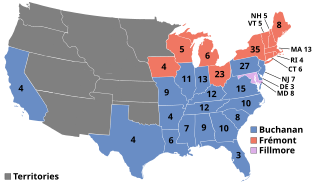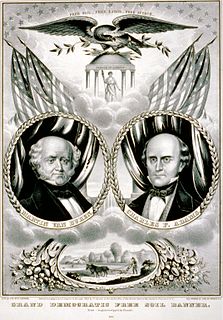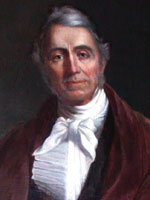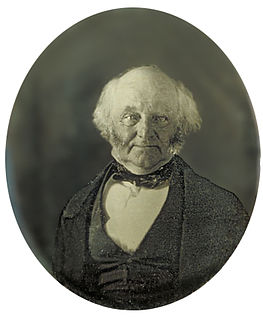
The 1848 United States presidential election was the 16th quadrennial presidential election, held on Tuesday, November 7, 1848. In the aftermath of the Mexican–American War, General Zachary Taylor of the Whig Party defeated Senator Lewis Cass of the Democratic Party.

The 1852 United States presidential election was the 17th quadrennial presidential election, held on Tuesday, November 2, 1852. Democrat Franklin Pierce, a former senator from New Hampshire, defeated Whig nominee General Winfield Scott.

The 1856 United States presidential election was the 18th quadrennial presidential election, held on Tuesday, November 4, 1856. In a three-way election, Democrat James Buchanan defeated Republican nominee John C. Frémont and Know Nothing nominee and former President Millard Fillmore.

The Free Soil Party was a short-lived coalition political party in the United States active from 1848 to 1854, when it merged into the Republican Party. The party was largely focused on the single issue of opposing the expansion of slavery into the western territories of the United States.
The Barnburners and Hunkers were the names of two opposing factions of the New York state Democratic Party in the mid-19th century. The main issue dividing the two factions was that of slavery, with the Barnburners being the anti-slavery faction. While this division occurred within the context of New York politics, it reflected the national divisions in the United States in the years preceding the American Civil War.

Thomas Morris was an American politician from Ohio who served in the United States Senate and was a member of the Democratic Party. In the 1844 presidential election, he was the vice presidential nominee of the anti-slavery Liberty Party.

Marcus Morton was an American lawyer, jurist, and politician from Taunton, Massachusetts. He served two terms as Governor of Massachusetts and several months as Acting Governor following the death in 1825 of William Eustis. He served for 15 years as an associate justice of the Massachusetts Supreme Judicial Court, all the while running unsuccessfully as a Democrat for governor. He finally won the 1839 election, acquiring exactly the number of votes required for a majority win over Edward Everett. After losing the 1840 and 1841 elections, he was elected in a narrow victory in 1842.

Horatio Seymour was an American politician. He served as Governor of New York from 1853 to 1854 and from 1863 to 1864. He was the Democratic Party nominee for president in the 1868 United States presidential election, won by Republican and General Ulysses S. Grant.

Lewis Davis Campbell was an American politician as a U.S. Representative for Ohio. Over his political career he was elected as a Whig, Republican, Know Nothing, and Democrat.

George Washington Julian was a politician, lawyer, and writer from Indiana who served in the United States House of Representatives during the 19th century. A leading opponent of slavery, Julian was the Free Soil Party's candidate for vice president in the 1852 election and was a prominent Radical Republican during the American Civil War and the Reconstruction era.
The following table indicates the party of elected officials in the U.S. state of Connecticut:
The Liberty Party was a minor political party in the United States in the 1840s. The party was an early advocate of the abolitionist cause and it broke away from the American Anti-Slavery Society (AASS) to advocate the view that the Constitution was an anti-slavery document. William Lloyd Garrison, leader of the AASS, held the contrary view, that the Constitution should be condemned as an evil pro-slavery document. The party included abolitionists who were willing to work within electoral politics to try to influence people to support their goals. By contrast, the radical Garrison opposed voting and working within the system. Many Liberty Party members joined the anti-slavery Free Soil Party in 1848 and eventually helped establish the Republican Party in the 1850s.
The 1854 and 1855 United States Senate elections were elections which saw the final decline of the Whig Party and the maintained majority of the Democrats. Those Whigs in the South who were opposed to secession ran on the "Opposition Party" ticket, and were elected to a minority. Along with the Whigs, the Senate roster also included Free Soilers, Know Nothings, and a new party: the Republicans. Only five of the twenty-one senators up for election were re-elected.

The Free Soil Party was organized for the 1848 US election to oppose further expansion of slavery into the western territories. It included anti-slavery members of the Whigs, and drew much of its support anti-slavery Democrats, including former President Martin Van Buren.

The 1854 Massachusetts gubernatorial election was held on November 15. American Party candidate Henry J. Gardner was elected to his first term as governor, defeating incumbent Whig Governor Emory Washburn.

The 1854 Connecticut gubernatorial election was held on April 3, 1854. Former state legislator and Whig Party nominee Henry Dutton defeated former congressman and Democratic nominee Samuel Ingham and former congressman Charles Chapman with 31.89% of the vote.

The 1854 Vermont gubernatorial election for governor of Vermont took place on September 5. The Whig nominee was Stephen Royce, former Chief Justice of the Vermont Supreme Court. The Democratic nominee was Merritt Clark, and Lawrence Brainerd ran as the nominee of the Free Soil Party even as he was one of the organizers of the new anti-slavery Republican Party and appeared as a Whig candidate for the Vermont Senate on the ballot in Franklin County. Whig William C. Kittredge was nominated for governor against his wishes by advocates of the Temperance movement and Democrat Horatio Needham also attracted the support of some Free Soil advocates.

The 1855 Vermont gubernatorial election for governor of Vermont was held on September 4. With the Whig Party defunct after 1854, incumbent Stephen Royce, who had run with the support of both Whigs and the new Republican Party in 1854, ran as the nominee of the Republicans. The Democratic candidate was Merritt Clark, who had run unsuccessfully against Royce in 1854. James M. Slade, the Clerk of the Vermont House of Representatives was the nominee of the Know Nothing Party, also called the American Party.

The 1850 Massachusetts gubernatorial election was held on November 12.

The 1853 Ohio gubernatorial election was held on October 11, 1853.













